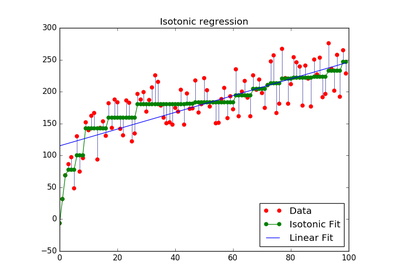sklearn.isotonic.IsotonicRegression¶
-
class
sklearn.isotonic.IsotonicRegression(y_min=None, y_max=None, increasing=True, out_of_bounds='nan')[源代码]¶ Isotonic regression model.
The isotonic regression optimization problem is defined by:
min sum w_i (y[i] - y_[i]) ** 2 subject to y_[i] <= y_[j] whenever X[i] <= X[j] and min(y_) = y_min, max(y_) = y_max
- where:
y[i]are inputs (real numbers)y_[i]are fittedXspecifies the order. IfXis non-decreasing theny_is non-decreasing.w[i]are optional strictly positive weights (default to 1.0)
Read more in the User Guide.
Parameters: y_min : optional, default: None
If not None, set the lowest value of the fit to y_min.
y_max : optional, default: None
If not None, set the highest value of the fit to y_max.
increasing : boolean or string, optional, default: True
If boolean, whether or not to fit the isotonic regression with y increasing or decreasing.
The string value “auto” determines whether y should increase or decrease based on the Spearman correlation estimate’s sign.
out_of_bounds : string, optional, default: “nan”
The
out_of_boundsparameter handles how x-values outside of the training domain are handled. When set to “nan”, predicted y-values will be NaN. When set to “clip”, predicted y-values will be set to the value corresponding to the nearest train interval endpoint. When set to “raise”, allowinterp1dto throw ValueError.Attributes: X_ : ndarray (n_samples, )
A copy of the input X.
y_ : ndarray (n_samples, )
Isotonic fit of y.
X_min_ : float
Minimum value of input array X_ for left bound.
X_max_ : float
Maximum value of input array X_ for right bound.
f_ : function
The stepwise interpolating function that covers the domain X_.
Notes
Ties are broken using the secondary method from Leeuw, 1977.
References
Isotonic Median Regression: A Linear Programming Approach Nilotpal Chakravarti Mathematics of Operations Research Vol. 14, No. 2 (May, 1989), pp. 303-308
Isotone Optimization in R : Pool-Adjacent-Violators Algorithm (PAVA) and Active Set Methods Leeuw, Hornik, Mair Journal of Statistical Software 2009
Correctness of Kruskal’s algorithms for monotone regression with ties Leeuw, Psychometrica, 1977
Methods
fit(X, y[, sample_weight])Fit the model using X, y as training data. fit_transform(X[, y])Fit to data, then transform it. get_params([deep])Get parameters for this estimator. predict(T)Predict new data by linear interpolation. score(X, y[, sample_weight])Returns the coefficient of determination R^2 of the prediction. set_params(**params)Set the parameters of this estimator. transform(T)Transform new data by linear interpolation -
fit(X, y, sample_weight=None)[源代码]¶ Fit the model using X, y as training data.
Parameters: X : array-like, shape=(n_samples,)
Training data.
y : array-like, shape=(n_samples,)
Training target.
sample_weight : array-like, shape=(n_samples,), optional, default: None
Weights. If set to None, all weights will be set to 1 (equal weights).
Returns: self : object
Returns an instance of self.
Notes
X is stored for future use, as transform needs X to interpolate new input data.
-
fit_transform(X, y=None, **fit_params)[源代码]¶ Fit to data, then transform it.
Fits transformer to X and y with optional parameters fit_params and returns a transformed version of X.
Parameters: X : numpy array of shape [n_samples, n_features]
Training set.
y : numpy array of shape [n_samples]
Target values.
Returns: X_new : numpy array of shape [n_samples, n_features_new]
Transformed array.
-
get_params(deep=True)[源代码]¶ Get parameters for this estimator.
Parameters: deep: boolean, optional :
If True, will return the parameters for this estimator and contained subobjects that are estimators.
Returns: params : mapping of string to any
Parameter names mapped to their values.
-
predict(T)[源代码]¶ Predict new data by linear interpolation.
Parameters: T : array-like, shape=(n_samples,)
Data to transform.
Returns: T_ : array, shape=(n_samples,)
Transformed data.
-
score(X, y, sample_weight=None)[源代码]¶ Returns the coefficient of determination R^2 of the prediction.
The coefficient R^2 is defined as (1 - u/v), where u is the regression sum of squares ((y_true - y_pred) ** 2).sum() and v is the residual sum of squares ((y_true - y_true.mean()) ** 2).sum(). Best possible score is 1.0 and it can be negative (because the model can be arbitrarily worse). A constant model that always predicts the expected value of y, disregarding the input features, would get a R^2 score of 0.0.
Parameters: X : array-like, shape = (n_samples, n_features)
Test samples.
y : array-like, shape = (n_samples) or (n_samples, n_outputs)
True values for X.
sample_weight : array-like, shape = [n_samples], optional
Sample weights.
Returns: score : float
R^2 of self.predict(X) wrt. y.


